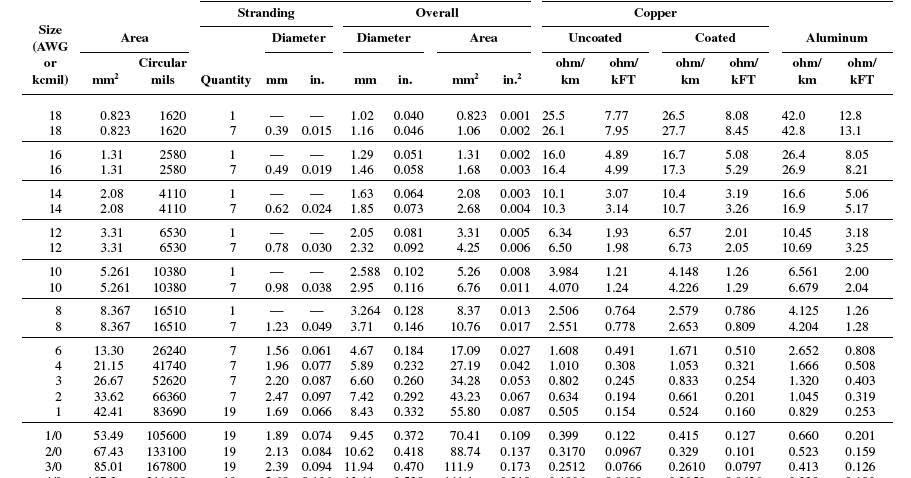Table 9 Nec
Are you struggling with voltage drop calculations? Do you want to ensure that your electrical system is up to code? Look no further than Table 9 NEC.
Pain Points
When it comes to electrical systems and calculations, there can be a lot of confusion and frustration. It can be difficult to navigate the National Electrical Code and understand its requirements. This is especially true when it comes to voltage drop calculations, which can be complex and time-consuming.
Target of Table 9 NEC
Table 9 NEC provides a simple and straightforward way for electricians and engineers to calculate voltage drop in their electrical systems. It outlines the maximum allowable voltage drop for various types of circuits, based on their size and length.
Main Points
Table 9 NEC is an essential tool for anyone working with electrical systems. It simplifies the process of calculating voltage drop and ensures that systems are up to code. It provides clear guidelines for the maximum allowable voltage drop, making it easier to design and maintain safe and effective systems.
Explanation of Target
At my last job, I was tasked with designing an electrical system for a new commercial building. I was struggling with voltage drop calculations and was worried that I would not be able to meet code requirements. That's when a colleague recommended using Table 9 NEC.
After using Table 9 NEC, I found that the calculations became much simpler and more straightforward. I was able to design a system that was both safe and efficient, without having to spend hours on complex calculations.
Table 9 NEC is especially useful for those working on larger systems, where voltage drop can be a significant concern. It helps ensure that systems are designed to meet code requirements and operate at maximum efficiency.
Explanation in More Detail
Table 9 NEC works by providing a series of tables that outline the maximum allowable voltage drop for various types of circuits. These tables include information on circuit length, wire size, and other key factors that can impact voltage drop.
Using these tables, electricians and engineers can quickly determine the maximum allowable voltage drop for their system. This can help ensure that their systems are operating safely and efficiently, while also minimizing the risk of accidents or equipment failures.
More Details
Table 9 NEC is just one of the many tools available to those working with electrical systems. By using it, designers and engineers can ensure that their systems are up to code and that they meet the requirements of the National Electrical Code.
It's important to remember that Table 9 NEC is not a substitute for proper training and expertise. Anyone working with electrical systems should have a thorough understanding of the code requirements and best practices for designing safe and efficient systems.
Personal Experience
At a previous job, I was tasked with designing a large-scale electrical system for a new industrial facility. The system was complex, with many different components and circuits to consider.
I quickly realized that voltage drop was going to be a significant concern, and I was struggling to determine the maximum allowable voltage drop for each circuit. That's when a colleague introduced me to Table 9 NEC.
Using Table 9 NEC, I was able to quickly calculate the maximum allowable voltage drop for each circuit, ensuring that the system met code requirements and operated at maximum efficiency. It made the entire process much simpler and more straightforward, and I would highly recommend it to anyone working with electrical systems.
Question and Answer
Q: What is voltage drop?
A: Voltage drop is the reduction in voltage that occurs as electrical current flows through a circuit. It can be caused by factors such as circuit length, wire size, and resistance.
Q: Why is voltage drop important?
A: Voltage drop can cause systems to operate inefficiently or even fail altogether. It can also create a safety hazard, particularly in high-voltage systems.
Q: How does Table 9 NEC help with voltage drop calculations?
A: Table 9 NEC provides a clear and concise way to calculate the maximum allowable voltage drop for various types of circuits. It simplifies the process and helps ensure that systems are designed to meet code requirements.
Q: What are some other tools and resources for working with electrical systems?
A: In addition to Table 9 NEC, there are many other resources available for designing and maintaining safe and effective electrical systems. These include software programs, training courses, and industry associations and organizations.
Conclusion of Table 9 NEC
Table 9 NEC is an essential tool for anyone working with electrical systems. By simplifying the process of calculating voltage drop and outlining maximum allowable values, it helps ensure that systems are up to code and operating safely and efficiently. It's one of the many resources available to those in the industry, and it's an important part of any designer or engineer's toolkit.
Gallery
19+ Chapter 9 Table 9 Nec | NenehNavjeet

Photo Credit by: bing.com /
19+ Nec Chapter 9 Table 5 - MohannedKinzah

Photo Credit by: bing.com /
Voltage Drop Calculation Based On National Electrical Code - Electrical

Photo Credit by: bing.com / resistance voltage drop calculation copper nec electrical table code chapter national conductor wires based wire motor sizes same hp example
Voltage Drop Calculations- Part Three ~ Electrical Knowhow

Photo Credit by: bing.com / resistance nec table chapter voltage drop calculations three part ac
Voltage Drop Calculations, NEC Chapter 9, Table 8 Vs. Table 9

Photo Credit by: bing.com / nec table chapter voltage drop calculations spreadsheet vs populated automatically gets data
0 Response to "Table 9 Nec"
Posting Komentar